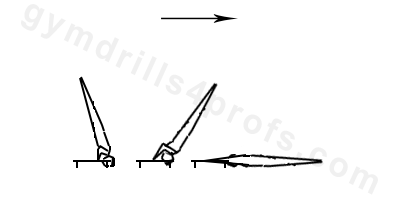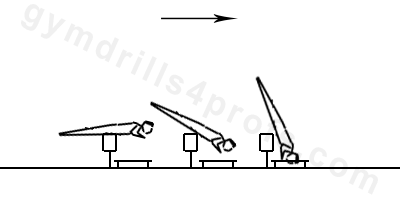


The forward baby giant is usually learned prior to attempting a full giant swing. This skill helps the gymnast understand how to push down on the rings and increase the amplitude of the swings. It also helps the athlete learn to bail in a hollow body and maintain backward pressure on the rings. These concepts are important so that the gymnast gets a full range of motion through the bottom of the swing. The skill begins in a shoulder stand. As the gymnast falls back, the arms push down on the rings in order to create a bigger half circle down to the lower vertical. The body is straight and slightly extended. In the back swing, the legs should raise into vertical. The most important move is the “heel drive”. The arms should be parallel and gradually bend while pushing down on the rings. This allows the shoulders to raise at the level of the rings. The skill finishes in a shoulder stand position. During the move the head should be slightly open.

At the highest point in the back swing, the shoulders should be extended with the rings going slightly sideways. The body should be in an arched position. From the top of the swing, continuous shoulder extension toward the bottom of the swing must be maintained. This helps the gymnast maintain the arched body position until the bottom of the swing. At the bottom, the gymnast should kick the legs forward and upward to make their entire body turn over as fast as possible. The gymnast should attempt to kick from their upper chest at the bottom. Shoulder should remain extended and stay down until the entire body turns over completely. The rings should be pushed backward when the gymnast’s feet are pointed towards the ceiling. The rings should turn parallel (wrists facing one another). The rings should not go sideways during this portion of the swing. The final position is a higher point of the front swing, where the body should be in a slight hollow position with arms tight and parallel. The head should be neutral with the gymnast maintaining backward pressure on the rings. From the highest point of the front swing starts the backswing. The body should swing down in a hollow position without losing pressure on the rings. At the bottom, the gymnast should initiate a strong kick off their heels. During the turnover phase, the head should stay down to facilitate a stronger heel lift. Shoulders should remain low. When their heels have risen and their toes are directed upward toward the ceiling, the rings can be slightly open, the head will be slightly elevated as well. The final position of the backswing is arched. VERY IMPORTANT: In the backswing, do not pull down on the rings. The leading motion of the move is the kick back with the heels.

At the highest point in the back swing, the shoulders should be extended with the rings going slightly sideways. The body should be in an arched position. From the top of the swing, continuous shoulder extension toward the bottom of the swing must be maintained. This helps the gymnast maintain the arched body position until the bottom of the swing. At the bottom, the gymnast should kick the legs forward and upward to make their entire body turn over as fast as possible. The gymnast should attempt to kick from their upper chest at the bottom. Shoulder should remain extended and stay down until the entire body turns over completely. The rings should be pushed backward when the gymnast’s feet are pointed towards the ceiling. The rings should turn parallel (wrists facing one another). The rings should not go sideways during this portion of the swing. The final position is a higher point of the front swing, where the body should be in a slight hollow position with arms tight and parallel. The head should be neutral with the gymnast maintaining backward pressure on the rings. From the highest point of the front swing starts the backswing. The body should swing down in a hollow position without losing pressure on the rings. At the bottom, the gymnast should initiate a strong kick off their heels. During the turnover phase, the head should stay down to facilitate a stronger heel lift. Shoulders should remain low. When their heels have risen and their toes are directed upward toward the ceiling, the rings can be slightly open, the head will be slightly elevated as well. The final position of the backswing is arched. VERY IMPORTANT: In the backswing, do not pull down on the rings. The leading motion of the move is the kick back with the heels.

This drill could be done with parallettes or at the edge of the pit. The gymnast starts in a shoulder stand position. The gymnast should fall forward and push down on the bars. The trajectory of the legs should create a wide amplitude for the fall. The gymnast lands flat in a horizontal position.

The starting position is from a horizontal body position with the hips on a lower beam. The gymnast should kick backward with their heels up to shoulder stand on the parallettes.
Integral part of gymnastics coaching process are skill drills. They help gymnasts to learn easier and technically correct. With GYM DRILL PRO you will find variety of ideas for the most the basic gymnastics skills. There are plenty of images with skill drill progressions. It is intended to support explicitly the qualified coaches in their daily coaching business. DO NOT practice without the guidance of proper professionals.